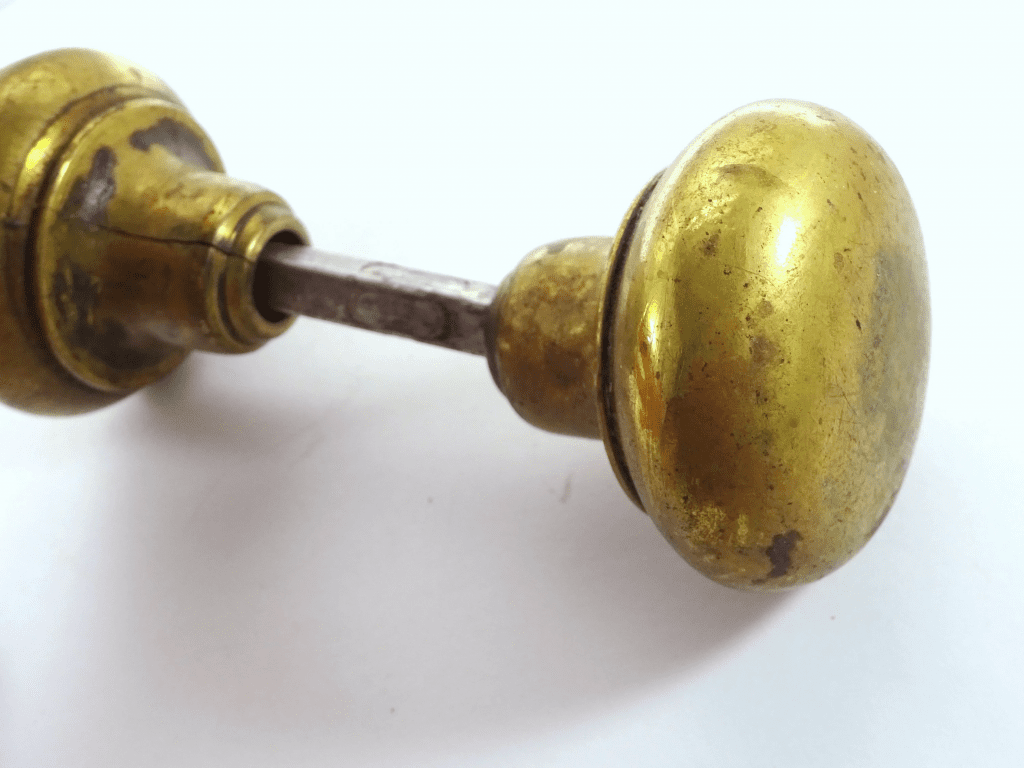A Small Item That Carries a Whole Generation’s Memories
Do you have enough “years of memory” to recognize this curious little piece? At first glance, it may look like a random vintage trinket… but anyone who grew up in an older home would instantly feel a wave of nostalgia. This small object — with its smooth yellow knob and rusty metal stem — once existed in nearly every household. Hold it in your hand, and it feels as if an entire era quietly comes back to life.
What you’re looking at is an antique doorknob, the kind used in homes from the 1920s through the 1950s. Before modern handles and sleek hardware became the norm, these round knobs were the heart of every door. They weren’t just functional — they were part of the charm and personality of old houses.
Let’s dive into the story behind this forgotten classic.

What Makes This Antique Doorknob So Special?
The moment you see the yellow, domed surface, you can tell this isn’t a modern piece. Many antique doorknobs were made using Bakelite, porcelain, early plastics, or resin-like materials that were incredibly durable for their time. The warm color wasn’t just aesthetic — it was a signature style of early 20th-century craftsmanship.
Its metal stem, thick and square, reveals how it worked: it slid through a traditional mechanical lock inside the door. Turn the knob, the spindle rotated, and the internal latch released. Simple, elegant, and surprisingly sturdy.
How Homes Once Looked With These Doorknobs
Imagine walking through a house in the 1930s or 1940s. Every bedroom door, every closet, every interior entryway had one of these knobs. They came in amber tones, milk-white porcelain, marbled brown, or deep black. Some even had decorative plates or hand-carved details around the base.
These knobs weren’t just accessories — they were part of the home’s personality. They clicked softly when turned. They warmed in your hand. They aged gracefully with time.
Today, modern handles feel efficient but lack the soul that antique doorknobs carried naturally.
Video : Original, Antique 1920s Glass Doorknob Brass Door Hardware Still Functional 2023
Why This Type of Doorknob Became So Popular
Several factors made these doorknobs essential in early homes:
- Durability: Bakelite was one of the first synthetic materials strong enough for everyday use.
- Affordability: They were cheaper than metal knobs and easier to produce.
- Aesthetic charm: Their warm tones matched wooden doors beautifully.
- Ease of installation: The spindle system was simple and universal.
They were so common that manufacturers produced them by the millions across Europe and America.
The Gradual Disappearance of the Antique Doorknob
By the mid-20th century, building styles changed. Designs became cleaner, metal hardware became more affordable, and new locking mechanisms replaced the old spindle-and-latch system. One by one, antique doorknobs were removed, tossed aside, or forgotten in storage boxes.
Today, they survive mostly in:
- old renovated houses
- architectural salvage shops
- vintage markets
- the collections of people who love historical hardware
To younger generations, they’re mysterious. To older generations, they’re emotional reminders of childhood homes, grandparents’ houses, and the architectural style of another time.

The Materials That Made These Knobs Iconic
Most antique doorknobs of this style used:
- Bakelite (early plastic) — warm-toned, durable, slightly translucent
- Porcelain — glossy, smooth, classic
- Hard resin or composite materials — often in amber or cream colors
The knob in the photo appears to be Bakelite or an early resin version — popular from the 1920s onward. Its color, shape, and texture perfectly capture the look of pre-war and post-war home interiors.
Why People Collect These Forgotten Gems Today
Collectors adore antique doorknobs for many reasons:
- they’re unique pieces of design history
- they show early craftsmanship in synthetic materials
- each one has its own patina, character, and story
- they’re small, easy to display, and full of nostalgia
Many people even reuse them in modern home décor — on drawers, cabinets, or as decorative hooks — transforming a forgotten tool into a nostalgic design piece.
Video : The SHOCKING Truth About Antique Doorknob Replacement Exposed
A Small Object With a Big Story
Touching an old doorknob like this can feel surprisingly emotional. It reminds you of doors that creaked softly. Rooms filled with stories. Houses that no longer exist but live on in memory. It’s incredible how something so ordinary once played such a central role in everyday life.
Conclusion
This small yellow object may confuse people today, but it once opened nearly every door in homes across the early 20th century. The antique doorknob wasn’t just a piece of hardware — it was part of the rhythm of daily living, part of the warmth of old houses, part of memories people still hold close. Its weight, its shape, and its charm capture a moment in time that has quietly slipped away. And now, when you hold it, you don’t just hold a tool — you hold a little piece of history.